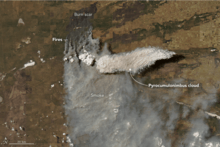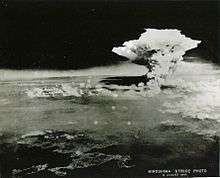Cumulonimbus flammagenitus
The cumulonimbus flammagenitus cloud (CbFg), also known as the pyrocumulonimbus cloud, is a type of cumulonimbus cloud that forms above a source of heat, such as a wildfire or volcanic eruption,[5] and may sometimes even extinguish the fire that formed it.[6] It is the most extreme manifestation of a flammagenitus cloud. According to the American Meteorological Society’s Glossary of Meteorology, a flammagenitus is "a cumulus cloud formed by a rising thermal from a fire, or enhanced by buoyant plume emissions from an industrial combustion process."[7] Analogous to the meteorological distinction between cumulus and cumulonimbus, the CbFg is a fire-aided or –caused convective cloud, like a flammagenitus, but with considerable vertical development. The CbFg reaches the upper troposphere or even lower stratosphere and may involve precipitation (although usually light),[8] hail, lightning, extreme low-level winds, and in some cases even tornadoes.[9] The combined effects of these phenomena can cause greatly increased fire-spread and cause direct dangers on the ground in addition to 'normal' fires.[9][10]



The CbFg was first recorded in related to fire following the discovery in 1998[8] that extreme manifestations of this pyroconvection caused direct injection of large abundances of smoke from a firestorm into the lower stratosphere.[11][12][13][14][15][16] The aerosol of smoke comprising CbFg clouds can persist for weeks, and with that, reduce ground level sunlight in the same manner as the “nuclear winter" effect.[9][17]
In 2002, various sensing instruments detected 17 distinct CbFg in North America alone.[18]
Notable events
1945 Hiroshima Firestorm, Japan
On 6 August 1945, an intense cumulonimbus-like cloud was photographed above Hiroshima, long after the cloud generated by the atomic bomb had dissipated. The cloud was a result of the firestorm that had by then engulfed the city.[2] Some 70,000–80,000 people, around 30% of the population of Hiroshima at the time, were killed by the blast and resultant firestorm.[23]
1991 Pinatubo 'Volcanic Thunderstorms', Philippines
Volcanic eruption plumes are not generally treated as CbFg, although they are convectively driven to a large extent[24] and for weaker eruptions may be significantly enhanced in height in convectively unstable environments.[25] However, for some months after the climactic eruption of Mt Pinatubo in the Philippines in 1991, meteorological observers from the US military observed what they termed 'volcanic thunderstorms' forming near the summit: cumulus cloud complexes formed near the top of the buoyant ash plume, and frequently developed into cumulonimbus clouds (thunderstorms). The thunderstorms often drifted away from their source region at the top of the plume, producing sometimes significant amounts of localized rainfall, "mudfall," and ash fall. They also noted that thunderstorms formed over hot flows and secondary explosions even in the absence of any eruption.[26] Further investigations confirmed that the volcano had clearly enhanced the convective environment, causing thunderstorms to form on average earlier in the day and more reliably than in surrounding areas, and that the presence of volcanic ash in cloud tops in the upper troposphere could be inferred from satellite imagery in at least one case.[19]
2003 Canberra Firestorm, Australia
On 18 January 2003, a series of CbFg clouds formed from a severe wildfire, during the 2003 Canberra bushfires in Canberra, Australia.[9] This resulted in a large fire tornado, rated F3 on the Fujita scale: the first confirmed violent fire tornado.[27][28] The tornado and associated fire killed 4 people and injured 492.
2009 Black Saturday, Australia
On 7 February 2009, the Black Saturday bushfires killed 173 persons, destroyed over 2000 homes, burnt more than 450,000 ha, and resulted in losses of over four billion Australian dollars in Victoria, Australia. Multiple fire plumes produced a number of distinct CbFg, some of which reached heights of 15 km on that day and generated a large amount of lightning[29]
2019 'Fire Tornado' fatality, Australia
On 30 December 2019, two fire response vehicles were overturned by what was described as a 'fire tornado' originating from an active cumulonimbus flammagenitus cloud near Jingellic, New South Wales, Australia, on a day when multiple CbFg were recorded in the neighbouring State of Victoria to an altitude of at least 16 km.[30] One of these vehicles was variously described as weighing between 8 and 12 tonnes.[10][31] The incident resulted in one fatality and injuries to two others.
See also
References
- "A Photo-Essay on the Bombing of Hiroshima and Nagasaki". University of Illinois at Urbana-Champaign. Retrieved December 4, 2016.
- Broad, William J. (May 23, 2016). "The Hiroshima Mushroom Cloud That Wasn't". The New York Times. Retrieved December 4, 2016.
- Toon et al. 2007, p. 1994.
- Fromm, Michael; Alfred, Jerome; Hoppel, Karl; et al. (May 1, 2000). "Observations of boreal forest fire smoke in the stratosphere by POAM III, SAGE II, and lidar in 1998". Geophysical Research Letters. 27 (9): 1407–1410. Bibcode:2000GeoRL..27.1407F. doi:10.1029/1999GL011200. Archived from the original on January 6, 2009. Retrieved August 29, 2013.
- WMO. "Explanatory remarks and special clouds". International Cloud Atlas. Retrieved 2020-01-01.
- Csifo, Noemi. "Fire Cloud Cumulus Cumulonimbus Weather". Sciences 360. R R Donelley. Retrieved 22 October 2013.
- "AMS Glossary". American Meteorological Society. Retrieved 1 January 2020.
- Fromm, Michael; Lindsey, Daniel T.; Servranckx, René; Yue, Glenn; Trickl, Thomas; Sica, Robert; Doucet, Paul; Godin-Beekmann, Sophie (2010). "The untold story of pyrocumulonimbus, 2010". Bulletin of the American Meteorological Society. 91 (9): 1193–1210. Bibcode:2010BAMS...91.1193F. doi:10.1175/2010BAMS3004.1.
- Fromm, M.; Tupper, A.; Rosenfeld, D.; Servranckx, R.; McRae, R. (2006). "Violent pyro-convective storm devastates Australia's capital and pollutes the stratosphere". Geophysical Research Letters. 33 (5): L05815. Bibcode:2006GeoRL..33.5815F. doi:10.1029/2005GL025161.
- Nguyen, Kevin (2019-12-31). "Young father-to-be dies as fire tornado flips truck onto its back". ABC News. Retrieved 2020-01-01.
- Fire-Breathing Storm Systems. NASA
- Averill, Clare; Logan, Jennifer (August 19, 2004). "Smoke Soars to Stratospheric Heights". Earth Observatory. NASA. Retrieved March 10, 2013.
- Fromm, Michael; Alfred, Jerome; Hoppel, Karl; et al. (May 1, 2000). "Observations of boreal forest fire smoke in the stratosphere by POAM III, SAGE II, and lidar in 1998". Geophysical Research Letters. 27 (9): 1407–1410. Bibcode:2000GeoRL..27.1407F. doi:10.1029/1999GL011200. Archived from the original on January 6, 2009. Retrieved August 29, 2013.
- Fromm, M.; Stocks, B.; Servranckx, R.; et al. (2006). "Smoke in the Stratosphere: What Wildfires have Taught Us About Nuclear Winter". Eos, Transactions, American Geophysical Union. 87 (52 Fall Meet. Suppl): Abstract U14A–04. Bibcode:2006AGUFM.U14A..04F. Archived from the original on October 6, 2014.CS1 maint: unfit url (link)
- Fromm, M.; Servranckx, R. (2003). "Transport of forest fire smoke above the tropopause by supercell convection". Geophysical Research Letters. 30 (10): 1542. Bibcode:2003GeoRL..30.1542F. doi:10.1029/2002GL016820.
- Jost, Hans-Jürg; Drdla, Katja; Stohl, Andreas; et al. (June 2, 2004). "In-situ observations of mid-latitude forest fire plumes deep in the stratosphere" (PDF). Geophysical Research Letters. 31 (11): L11101. Bibcode:2004GeoRL..3111101J. doi:10.1029/2003GL019253. hdl:11858/00-001M-0000-002A-D630-D. CiteID L11101. Retrieved August 31, 2013.
- Fromm, M.; Stocks, B.; Servranckx, R.; et al. (2006). "Smoke in the Stratosphere: What Wildfires have Taught Us About Nuclear Winter". Eos, Transactions, American Geophysical Union. 87 (52 Fall Meet. Suppl): Abstract U14A–04. Bibcode:2006AGUFM.U14A..04F. Archived from the original on October 6, 2014.CS1 maint: unfit url (link)
- Fire-Breathing Storm Systems. NASA
- Tupper, Andrew; Oswalt, J. Scott; Rosenfeld, Daniel (2005). "Satellite and radar analysis of the volcanic-cumulonimbi at Mount Pinatubo, Philippines, 1991". Journal of Geophysical Research: Atmospheres. 110 (D9): D09204. Bibcode:2005JGRD..110.9204T. doi:10.1029/2004JD005499. ISSN 2156-2202.
- "When bushfires make their own weather - Social Media Blog - Bureau of Meteorology". media.bom.gov.au. Retrieved 2020-01-01.
- WMO. "Flammagenitus". International Cloud Atlas. Retrieved 2020-01-01.
- "New International Cloud Atlas: 19th century tradition, 21st century technology". World Meteorological Organization. 2017-03-22. Retrieved 2020-01-01.
- "Atomic bombings of Hiroshima and Nagasaki", Wikipedia, 2019-12-27, retrieved 2020-01-01
- Sparks, R. S. J. (Robert Stephen John), 1949- (1997). Volcanic plumes. Wiley. OCLC 647419756.CS1 maint: multiple names: authors list (link)
- Tupper, Andrew; Textor, Christiane; Herzog, Michael; Graf, Hans-F.; Richards, Michael S. (2009-11-01). "Tall clouds from small eruptions: the sensitivity of eruption height and fine ash content to tropospheric instability". Natural Hazards. 51 (2): 375–401. doi:10.1007/s11069-009-9433-9. ISSN 1573-0840.
- Oswalt, J. S., W. Nichols, and J. F. O'Hara (1996). "Meteorological observations of the 1991 Mount Pinatubo eruption, in Fire and Mud: Eruptions and Lahars of Mount Pinatubo, Philippines, edited by C. G. Newhall, and R. S. Punongbayan, pp. 625– 636, Univ. of Wash. Press, Seattle". Retrieved 1 January 2020.CS1 maint: multiple names: authors list (link)
- Anja Taylor (6 June 2013). "Fire Tornado". Australian Broadcasting Corporation. Retrieved 6 June 2013.
- McRae, R; Sharpies, J; Wilkies, S; Walker, A (12 October 2012). "An Australian pyro-tornadogenesis event". Nat Hazards. 65 (3): 1801. doi:10.1007/s11069-012-0443-7.
- Dowdy, Andrew J.; Fromm, Michael D.; McCarthy, Nicholas (2017). "Pyrocumulonimbus lightning and fire ignition on Black Saturday in southeast Australia". Journal of Geophysical Research: Atmospheres. 122 (14): 7342–7354. Bibcode:2017JGRD..122.7342D. doi:10.1002/2017JD026577. ISSN 2169-8996.
- "Lives and homes under threat as bushfires rage across Victoria". 7NEWS.com.au. 2019-12-29. Retrieved 2020-01-01.
- Noyes, Laura Chung, Jenny (2019-12-31). "'Extraordinary weather event' led to death of firefighter Samuel McPaul". The Sydney Morning Herald. Retrieved 2020-01-01.